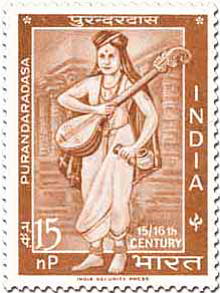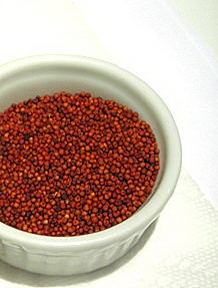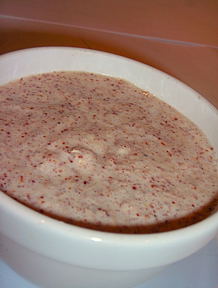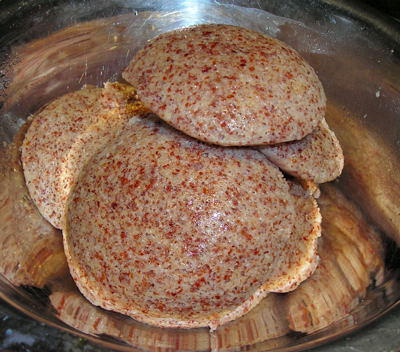by Janani Srinivasan
Students and Rasikas of Karnatic classical music who fondly (or not 🙂 ) recall their first tentative forays into “Sarali” and “Janta Varisais” might also remember that the credit for a creating a pedagogy of Karnatic classical music goes to Sri. Purandaradasa. And if your mother was a particularly determined woman, you may even have dutifully trotted out works from his corpus to bored admiring relatives come socio-religious occasions like Navarathri and Varamahalakshmi Vratha gatherings.
Whether it is Ratnakara the bandit turned into the Adikavi Sri.Valmiki Muni, or Angulimala the grisly finger-slicing highway terrorist turned Buddhist monk, tales of what can fairly be called instantaneous and extreme spiritual makeovers have captured the imaginations of generations of Indian story tellers and their listeners for centuries. The narrative arc usually progresses along the lines of hopelessly-and-diabolically-evil-person reaches the apogee of his (supported usually by a silently long-suffering her) evilness when a chance encounter; usually in the form of divine grace; completely awakens and transforms said individual. They then attain a sort of mythic stature and are held up as role models for future generations to emulate. Indeed, the story of the rapaciously greedy miser-turned musician-mystic Sri Purandaradasa is a familiar and inspiring one to many of us who grew up listening to these tales. Wiki weighs in with a more complete history of Sri Purandaradasa.

Stamp Commemorating Sri Purandaradasa
In our family, one of our all-time personal favourites from his oeuvre remains the haunting “Ragi Tandira”. Kannada speakers will identify with the clever punning on the word “Ragi”. Much like a Zen koan, the lyrics here have layers of meaning couched in seemingly quotidian references.
Indeed it is not hard to surmise that Purandhara dasa, once he became a wandering minstrel after giving up his former materialistic life, must have still been intimately familiar with the kind of people that once made up his close family and friends circle. Hence, his desire to show them the path to a more richer inner life must have been tempered with the practical consideration that they might reject his message if he was too heavy handed or preachy.
This composition opens with the poet singing, “Have you brought Ragi for alms?” He then goes on to describe Ragi in glowing adjectives “Yogyaragi , Bhogyaragi” and so on… While in one sense, it can be read as an extolling of Ragi, the staple local grain, the sustainer of life itself with various adjectives: Yogya (worthy) + Ragi, Bhogya (enjoyable) + Ragi ; on another level, it is a veiled injunction to the householders themselves to become “worthy”, “Yogyaragi” as one word.
Here the notion of “Yogyatha” like many words in the vernacular, defies simplistic translation. It is a conflation of many shades of meaning conveying a sense of worthiness, deservingness, etc. The rest of the song progress in the same vein exhorting us to various acts of goodness like offering food to the needy (anna chatrava nittavarAgi), attaining fame for the right reasons (kyathiyali migilAdavarAgi) and cautioning us to stay away from inethical practices (anya varthegaLa bittavarAgi) and so on.
So as homage to Sri Purandharadasa, his beloved Vittala and the ancient grain sustaining generations of his people; here is my mother’s recipe for Ragi Idlis. What a song and dance over a simple grain you say? Well, just try these. Like a mother’s love, these are earthy and wholesome. In a word, Perfect!


Ragi Grains ……………………. Sprouted Ragi and Rice Batter for Idlies
Recipe:
(Makes atleast 2 dozen of the standard sized Idlis- but quantity yielded depends on the Idli mould size.)
Whole Ragi Grain- 1 cup
(I sprouted these for added nutritional benefits. But it’s not strictly necessary)
Idli rice (parboiled) – 1 cup
Whole skinned Urad dal – ¾ cup
Methi seeds -1 tablespoon
Salt to taste
Sesame oil- to grease idli moulds (I used “Idhayam” brand)
After multiple washes, soak the Ragi for a day. Drain and let it rest for another day till you see tiny white sprouts. Alternatively, you can skip the sprouting and just soak the ragi for 3-4 hours longer than you soak the rice. Soak rice, whole urad and methi seeds in separate containers for 4-6 hours or overnight.
In a wet grinder or a mixie /blender, grind the urad dal till light and fluffy. A test for fluffiness is to keep a bowl of water and drop a tiny pinch of batter. If it floats, it is light enough. Then add and grind the Ragi grains and Methi and finally the rice. Take care that the rice should not be ground too smooth. It should be of rice Rava consistency. Alternatively, you can use rice Rava instead. Take the batter in a vessel, fold in some salt to taste and leave it overnight to ferment. I found that the dough fermented really well, doubling up and overflowing the vessel. So take adequate precautions.
Next morning, lightly stir the well fermented batter. Grease Idli moulds and steam in a pressure cooker for 12-15 minutes till done. Ragi idlis can be served with a dollop of butter or ghee on top, along with the usual fixings on the side: sambar, coconut chutney and/or Milagai Podi.
~ Article by Janani Srinivasan

Light and Soft Ragi Idlies
Notes:
Audio of Ragi Tandira sung by the late Sri. Maharajapuram Santhanam in Raga Kalyanavasantham – Link.
Ragi pronounced with “Ra†as “raaâ€Â, “G†as in God not as in gentle, “i†pronounced “eeâ€Â.
Tandira pronounced Thundheera with the “h†NOT aspirated. “T†and “d†sounds softened not sharp as in the common American/English usage and the “an†is pronounced “unâ€Â.
Janani Srinivasan’s articles on Mahanandi: It’s Chakalaka, Baby!, The Arisiupma Trilogy.

Hi Indira,
Ma family lo ippudu kotha member vachaaru. babu ku ippudu 6 nelalu. nenu meeku mail kooda chesanu.
ragi idly lu try chesthanu.
meerantlu dondakayalu ikkada kooda costly ne.
vepudu chesthe kooda 1/2 day ku sari pothundi. india lo vadi alavatu kavadam valla
ikkada eppudina kontanu adi fresh ga vunte.
1 mamidi kaya koni aavakaya pettanu 2months kritham..
chutney em chesaru idlys ki?
vineela
What a happy news! Congratulations dear Vineela.
Email naaku andaledu. Ayyo. Ekkado miss ayyindi, lekapothe Spam lo padinatlu vundi.
Aavakaya banguntindi kada. Nenu maamidi turumu pacchadi pettanu ee samvasharam, vaaram rojulalo ayipoyindi anta.:)
Janani and vaalla amma gaaru coconut-mint chutney chesaaru ragi idlies kosam. (Photos koncham cut chesaanu, chutney egiri poyindi.)
– Indira
Comment by vineela — November 1, 2007 @ 5:34 pm
oh, yeah, i remember the foray first wsith mayamalavagoula, and the janta varisais and the forced renditions in front of strangers. **shudder**
janani, i love your posts. they are so evocative.
i’m sure you’ve heard of ‘toli janmamuna’, where ragi is dissed in favour of rice. 😀
http://www.geocities.com/promiserani2/c2619.html
Comment by bee — November 1, 2007 @ 5:42 pm
You made me extremely happy today.
I was born in Pandharpur and I was very happy to see the link to Lord Vithal’s photo. I have family in Pandharpur and Lord Vithal has a very special place in my heart. Every summer vacation we used to go to Pandharpur and I used to play with my cousins in the Vithal temple.
Ahh!!To see my Panduranga , Vithala – nothing like it.
Comment by Anjali Damerla — November 1, 2007 @ 6:20 pm
Dear Indira,
Such a hauntingly beautiful post. It creates such serene vibrations as one reads it. We hope we see more posts like this one since you have captured that devotional ethos so well, in its ethereal magic.
I am going to try the ragi idlis tomorrow. I love Ragi, and even more, after reading this blessed post…and if it takes us forward to yogyata…definitely.
Thanks Indira.
Pritya: It’s beautifully composed post and written by Janani Srinivasan.
I am also planning to try this recipe with ragi flour, (we don’t get whole ragi here), ah the things we do to for that elusive yogyatha.:)
-Indira
Comment by Pritya — November 1, 2007 @ 7:20 pm
janani..what a delightful recipe..looks beautiful too…thnks for sharing..and indira thnks for bringing it to us via ur blog 🙂
Comment by Rajitha — November 1, 2007 @ 8:48 pm
Yes Indira, pls convey regards to Janani. Can we use the sprouted ragi flour available in market for this recipe?
Comment by Pritya — November 1, 2007 @ 9:03 pm
What a mesmeric post. I was instantly transferred to the days of Navarathri, where old maamas and maamis annoy with ‘One more song’ requests. Knowing Telugu you can appreciate the songs better. I had to get word by word translation from my Guru, but that was enough to understand what the Composer was going thru’.
Comment by Suganya — November 1, 2007 @ 10:48 pm
Thanks Indira for a Lovely song from purandaradasa. I loved it. Ragi Idlis are awesome. This is my first time to see raagi idlis. Definitely will try them. Can we add raagi flour instead of raagi itself?
Comment by Lakshmi — November 1, 2007 @ 11:54 pm
Bee: LOL:) I had heard Tolijumamuna before but kinda didn’t clue in to the ragi vs. varagu arisi debate. Thanks for the link and your kind words!
Rajitha/Pritya/Suganya/Lakshmi: Thanks for the encouraging comments! And yes; you can use ragi flour ; spruoted or otherwise. Before we found whole ragi grains that’s what my mom used and we had decent results as well.
The one thing my mom asked me to mention is that the ragi idlis should be steamed for a little longer than the regular idlis because ragi needs more steaming time. So 12-15 is what worked for me but you can leave it even longer depending on what works. Also, left over batter makes beautiful dosas..crisp yet chewy.
Comment by Janani — November 2, 2007 @ 6:44 am
Janani.. what an awesome write-up… enjoyed every line of it. The ragi idlis look gorgeous. I have some whole ragi so will definitely try this out. I can’t wait to make dosas as well using the batter after reading your description. Thank you.
🙂
Comment by Laavanya — November 2, 2007 @ 8:21 am
Lovely Post Janani and Indira! I totally relate to the entire first part! Innumerable gatherings, kirthanas sung and embarassements
🙂
Love the ragi idlis and the look of them!
Very nice.
Comment by Latha — November 2, 2007 @ 8:52 am
Never heard of it before. but it is such a healthy dish. I am going to make them and let you know how they turn out. Thanks for the great recipes.
Comment by Avany — November 2, 2007 @ 9:29 am
Janani, what a nice essay. ‘Ragi Tandira bhikshakke’ is my favourite song. A message to meditate and liveby.
I always keep singing it when i make Ragi malt on weekends:-)
Nice recipe on Idly. Sounds very healthy, being made of sprouted Ragi.
Indira and Janani, Blessed are you both for bringing such a beautiful Kriti to all of us. Thanks.
Comment by Madhuri — November 2, 2007 @ 11:35 am
Oh man, I remember my sarali varisai and janta varisai forays – that was one of the pinnacles of embarrassment! Only my mum could think that I had a fabulous voice that deserved grooming! 🙂
I was never a big ragi person, but I’m an idli freak – now you’ve gotten me hooked onto trying this!
Comment by Kaykat — November 2, 2007 @ 8:39 pm
Hi janani…I love the way you write…. when i was married into a karalite family i was introduced to ragi…. and realised that its the same ‘mabele’ had in africa!!
your writeup reminded me and now makes sense of some lines of a bhajan i kno….
“panduranga vittale…hari narayana
purandara vittale…hari narayana…”
thanks….will try the ragi idli….
Comment by Rachna — November 3, 2007 @ 4:00 am
If I keep wondering about something, I just have to come to ‘Mahanandi’ to find the answer being posted there. 🙂 I guess this has happened a few times now.
Indira, We just returned from a trip to India and have brought back some sprouted ragi flour and was wondering about what can I do with those, other than making yummy ‘ragi kanji’ or ‘ragi puttu’. Had no clue about the idli. Will try making the idli with the powder and let you know.
Janani, thanks for the beautiful write-up. Took me through some forced renditions of sarali/jandai varisai/thirupughazh in front of relatives. Esp. the one in which I had just told about my fund-raising for charity through school and my mom asked to sing for my uncles who were visiting us at the time. 2 mins into the song, the ‘perplexed’ uncles asked me to bring the paper and signed big bucks. I have no clue why they left very soon after though. 🙂
Janani, one quick question – I have seen ragi powders here in Toronto, not the whole ragi. where did you find these ragi? Or did it come from India?
Comment by Kay — November 3, 2007 @ 5:31 am
I have read so much about the nutrition value of Raagi that I want to try different recipes with it. So far the only thing that has stuck to me is Raagi Rotti. Thanks for this wonderful idea of using Raagi, urad daal, methi all in one. Awesome!
Comment by RedChillies — November 3, 2007 @ 7:30 am
Hi Kay: There’s a Sri Lankan Tamil store in downtown toronto..Ambal Groceries a few storefronts south of the intersection at Wellesley and Parliament. Over Navarathri, they had brought some. They plan to continue to bring them due to the high demand here. The label on the packet said its shipped from Mississauga though.
Lavanya/Latha/Madhuri: Thanks for the nice words.
Rachna: I know a Bhajan with those same lyrics as well..part of my school heritage:)
Comment by Janani — November 3, 2007 @ 8:32 am
Aha! Thanks Janani…. Will check it out and also try your ragi idli and let you know. I’m just making ragi dosas and it’s drinking oil like no other business.
Comment by Kay — November 3, 2007 @ 9:29 am
Wow … what a gr8 explanation of the song “ragithandira”. Its one of my favourite song and im a devotee of lord vittal of pandarpur. Very much delighted reading your post janani. Recipe is wonderful and healthier too… Having those idlis with a thought of lord vittal and sri.purandaradasa is so divine….
Comment by anusriram — November 7, 2007 @ 5:32 am
Hi,
I would like to know where we can get the whole ragi in atlanta(we live in atlanta)? and can we get in any american store? if so what it called? can you please provide the same…beautiful pictures….I can’t wait….
mail me soon…../Thanks….
Comment by sudha — November 8, 2007 @ 10:37 am
Anu: Thanks for the nice words.
Sudha: I don’t think Ragi is available outside of Indian stores and there too whole ragi is quite rare. Depends on the demand..Sorry can’t be more helpful.
Comment by Janani — November 8, 2007 @ 11:41 am
Where can we buy whole raagi? I have only seen powdered raagi in the Indian stores. In Wild Oats Market, they sell another variety of raagi – the yellow millet not red millet – can we use that instead for this recipe. Eager to try this recipe.
Comment by Shobana — November 8, 2007 @ 2:19 pm
Thanks Indira for this recipe. Made it last weekend and it was quite a hit!
Comment by Madhavi — November 12, 2007 @ 3:37 am
Hi Janani/Indira,
Janani, what a lovely post. Loved the language. Learnt carnatic music but I dont know a lot of Purandaradasaru songs although being a Kannadiga. Never heard this particular song too. Sounds beautiful. Do you know a web-site where I can download mp3s of some songs by him?
Also plan to try the idlis. My husband is a big fan of ragi but I dont have a lot of ideas on what to do with it. Now I got one more:).
Indira, thanks for bringing this post to us. I’ve tried several of your recipes and they turned out great.
Thanks again
Jyotsna
Comment by Jyo — November 18, 2007 @ 6:56 pm
Hi Jyotsna: Thanks for the nice comments. Try musicindiaonline..they don’t let you download but you can listen.
Comment by Janani — November 22, 2007 @ 9:19 am
the recipe and the website was great…lovely
Comment by neela — January 31, 2008 @ 3:24 am
Can you kindly tell me where I can buy Raggi seeds
Comment by Murali — March 6, 2008 @ 6:32 am
Hi Indira,
This picture has been copied here:
http://adukkula.blogspot.com/2009/10/ragi-idli.html
I wanted to bring it to your notice.
Comment by Raaga — October 26, 2009 @ 5:15 am
Hey Indira… very good n nutritious recipe. Can u tell me where can u buy whole grain Ragi…here in US….? I was said its illegal and u wont get here. Can u advice pls?
Comment by Shubha — April 25, 2011 @ 6:02 pm
Thanks for this recipe! These sprouted ragi idlis are delicious and nutritious.
Comment by Karuna — September 3, 2011 @ 11:22 am
[…] Adapted from: Mahanandi and Aayis Recipes […]
Pingback by Ragi Idli (Steamed Finger Millet Cakes) — June 6, 2017 @ 6:57 am